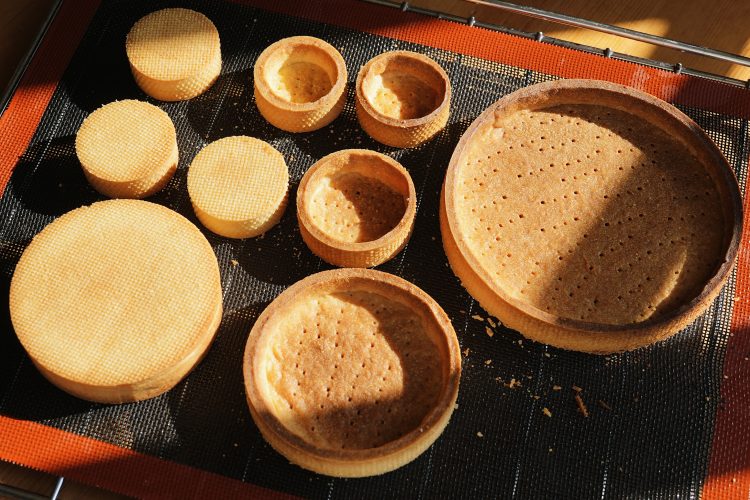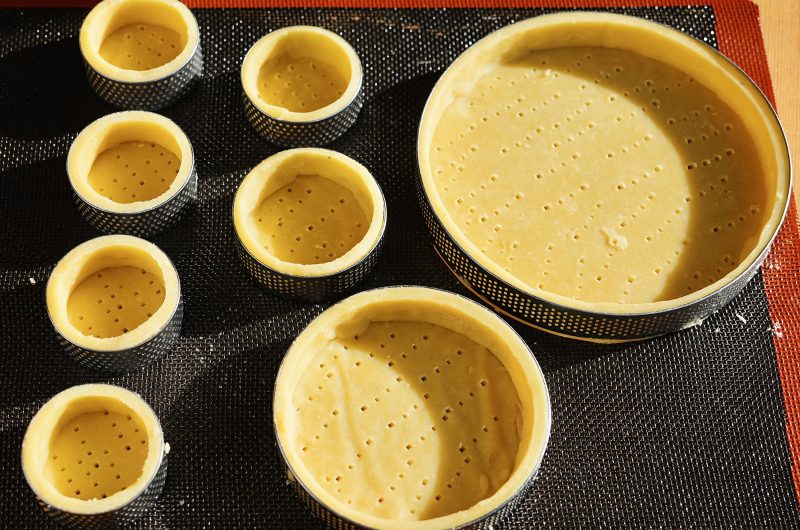Pâte Sucrée (Shortcrust Pastry)
Course: DessertCuisine: FrenchDifficulty: EasyServings
4-6
servingsPrep time
1
hourCooking time
15
minutesIngredients
200 gr plain flour
120 gr unsalted butter
25 g egg
65 g icing sugar
Pinch of salt
25 gr ground almond
Directions
- Mix the flour, icing sugar, almond meal and salt, then use your fingers to rub the butter in until it resembles breadcrumbs
- The mixture should be a bit like wet sand that can run through your fingers;
- Add egg and mix through with a rubber spatula until the mixture stiffens to the point you can’t really mix any more
- Now turn the dough out onto a work surface and use your hands to bring it together into a dough. You don’t need to knead it, just bring it together into a smooth ball;
- Shape the dough into a ball then pat it down, wrap with cling wrap, and refrigerate for 30 minutes or even overnight.
- Remove the dough from the fridge and unwrap. Note: If you refrigerated overnight or much longer than 30 minutes and the pastry is rock solid, leave it out for a bit until it softens enough that it can be rolled out
- Place the dough on a lightly-floured work surface, then sprinkle the dough surface lightly with flour
- Roll out into a 32cm, 3mm thick.
- To transfer the pastry into the tart tin, roll the pastry onto the rolling pin, taking care not to stretch the pastry. Stretching the pastry causes shrinkage when it bakes.
- Use your fingers to drape it in and gently coax it into the corners to fill the tart tin, as opposed to pulling or stretching it.
- Drape the excess pastry outside the rim of the tart tin, then roll the rolling pin across the surface to cut the excess off and remove excess pastry (but keep it, in case there’s a patching-up emergency to tend to later!)
- Prick the base with a fork. This allows steam to escape which stops the base from puffing up, so you have a nice smooth and not a bubbled base.
- Refrigerate for 30 minutes.
- Prepare blind baking – Cover the pastry with 2 large sheets of baking / parchment paper one on top of the other in a short “X”, then fill with baking beads (or beans) to weigh it down. The purpose of these weights is to prevent the base from puffing up and the sides from collapsing inwards during this blind baking stage.
- Bake at 180°C for:
• 15 minutes (Par Baked Crust) – if the tart, once filled, will be baked for more than 30 minutes; or
• 20 minutes (Fully Baked Crust) – if you are making a no-bake tart (ie. no baking once filled) or a tart that is baked 25 minutes or less once filled; - Bake uncovered – Return the uncovered tart crust to the oven and bake for a further:
• 5 minutes (Par Baked Crust) – if the tart, once filled, will be baked for more than 30 minutes; or
• 10 minutes (Fully Baked Crust) – if you are making a no-bake tart or a tart that is baked 25 minutes or less once filled. - Fully cool before filling – this will ensure the base stays nice and crispy rather than going soggy.
- How to prevent pastry dough from rising:
Dock the dough: Prick the base of the tart shells all over with a fork to let steam escape.
Freeze before baking: Line your molds with dough, then freeze solid (30–60 minutes) and bake directly from frozen.
Start baking at a lower temperature: Bake at 150°C (300°F) for the first 10 minutes, then increase to 170–175°C (340–350°F) to finish.
Roll the dough thinner: Roll the pastry to 2–3 mm thickness to prevent it from rising too much.
Use a denser dough recipe: Avoid over-creaming the butter and sugar (mix just until combined). Use a pâte sucrée or a dough with almond flour for a heavier, more stable texture.

